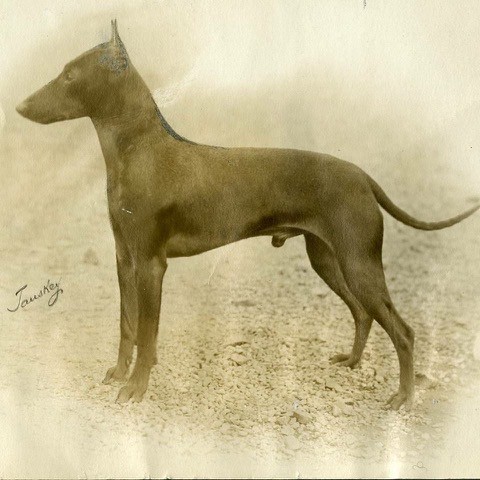... ennie im wochenendmodus!



... zumi@work.
bei jedem meeting genau so aufmerksam wie der papa.

... grace beobachtet ihr herrchen bei der arbeit ;-)

... für dich und deinen Hun
CACIB Nürnberg 13.01.2018
CURIOUS MADCAPS Divine Kate - Kate -
Championklasse
V1
BOB
Alpen Sieger
Judge: Zita Kotlas Sarnjai ( RS )



... grace unser blumenmädchen wünscht ein ruhiges und entspandes wochenende

Manchester Terrier Weight: Part 2 (Breed Standard Comparisons)
The “bomb cyclone” provided some downtime to write this, so it seemed like a good time to move the discussion of Manchester Terrier weight along.
It was actually pointed out to me that as a Toy person (and a Canadian to-boot), perhaps I wasn’t entitled to an opinion on this subject at all. I do take the point, however I’d actually argue that both of those things might make it easier for me to facilitate a fact-based discussion of the topic. Certainly, those who are in the thick of it have many emotions at play, making it hard to divorce current events from the bigger picture questions that really need to be discussed.
I’d also point out that, like many things in life, the Canada-US relationship in this case is much like the mouse and the elephant. As we have already seen based on changes made to the US breed standard in the 1990s, any modifications to the American standard affect Canadian dogs because the genepool in our breed is so heavily based in the US. So, with that in mind I will (with apologies to critics), soldier on as I think this conversation is not only important for SMT breeders but to our entire breed.
With that out of the way, now that we have talked about WHY we use weight as a measurement tool in our breed, I thought it might be helpful to back up a step and look at three associated issues:
1) How size is determined across all breeds.
2) The nature and role of disqualifying faults.
3) The rules around weighing and measuring.
None of these topics is specific to Manchesters alone, in fact to have the most constructive conversation possible it’s important that we try to apply the principles that underlie each as widely as possible while also looking at their relationship to and affect on our breed.
So, let’s start with how size is determined generally in dogs. Here are a few points to think about:
A) Breed Standards as a Whole
For interest’s sake, I did a quick search through AKC breed standards. Now, my numbers jotted on the back of an envelope aren’t scientific but they should be somewhat close. I counted 179 AKC breed standards that specify either prescribed or suggested size ranges in inches, pounds or both. For the sake of brevity, where a breed standard applied to multiple varieties I just counted it once.
Of those 179 breed standards, 94 (53%) contain measurements pertaining to height only; 70 (39%) contain measurements pertaining to height and weight together; and 15 (8%) measure size using weight alone. 54 (30%) of the breed standards that specify a size or size range contain a disqualification for size.
Of the breed standards that contain DQs related to size, 50 (93%) measure size in terms of height and 4 (7%) determine size using weight alone.
Looking at the list of the 15 breeds whose breed standards specify only weight is interesting. These breeds include: Dachshunds, Greyhounds, Boston Terriers, Bulldogs, French Bulldogs, Border Terriers, Brussels Griffon, Chihuahua, English Toy Spaniels, Maltese, Manchesters, Pekingese, Pomeranians, Pugs and Yorkshire Terriers.
Among those breeds, the breed standards for Manchester Terriers, Chihuahuas, Pekingese and French Bulldogs contain disqualifications for size. The Manchester Terrier is the only breed in this group that was not developed as a companion.
![]() ???? Form for Function
???? Form for Function
A few breeds stand out to me when I look at the list of breeds using weight alone as their tool for determining size. For example, the Greyhound’s use of weight seems quite strange to given the breed’s history as a coursing breed (only Greyhounds and Dachshunds are measured by weight in the entire hound group). Looking at the breed standard does provide some clues as to why this may be the case though, and also raises some questions about early breed standards.
Barring formatting, the AKC and CKC Greyhound breed standards both read identically and neither bears an approved or effective date, which tells me that this is likely the breed standard that was in place when the two organizations were formed. Additionally, like the CKC’s Manchester breed standard the Greyhound standard contains a scale of points indicating where and how much emphasis should be placed on different aspects of conformation, providing another indication of its age (most of the point scales have been removed over the years but it was very common in old standards and can still be found in some today). Given weight is such a strange choice for a large breed like this, I wonder if it was simply more common when dog shows began to determine size using weight. It would certainly be very interesting to know if other breeds were originally measured by weight and switched to a height standard at some point (I hope those with other breeds will pipe in if they know!).
The inclusion of the Bulldog and Boston Terrier on the list of weight-based standards is also interesting to me given both share some form of relation genetically and functionally through the same blood sports that the Manchester Terrier breed standard references.
Certainly, we know Bulldogs were popular in bull baiting and were crossed with terriers for the purposes of related sports like rat baiting. Like Manchesters, Boston Terriers also descend from bull and terrier crosses and were themselves used for pit ratting purposes. So the fact that Bulldogs and Bostons continue to use weight is not surprising, though it is notable that neither has an associated disqualification. Just as interesting, however, is the fact that the Bull Terrier, which was developed in parallel with the Manchester, has no reference in their breed standard to size at all.
OK, I’ll stop here—hopefully there are some things to chew on above and I hope others will pipe in.
I’m sure everyone will read something different into the above, but here are my takeaways after having read so many standards:
a) It is very uncommon in the context of modern dog shows for a breed standard to use weight alone as a measurement for size.
b) It is very rare to use weight as the basis for disqualifying a dog, with just 4 breeds (2%) among all of the breed standards I looked at citing weight as a disqualifying fault. Three of those breeds were developed as companions.
c) It is possible that weight was a more common tool for measurement when breed standards were originally written (please chime in if you have info to add).
d) Some of the breeds whose breed standards continue to use weight alone are related historically to Manchesters, either through ancestry or use in similar functions.
Amanda Kelly
... flo möchte aus dem spieleparadies abgehlt werden :-)

Ch. Queensbury Surprise in 1920 ![]() ????
????
![]() ????????《Manchester Terrier》
????????《Manchester Terrier》

... grace
na, kann ich nicht lieb schauen?

bekomme ich jetzt etwas zum knabbern?

das ist lecker

Vaginaler Ausfluss ist bei Hündinnen nicht selten schon vor der ersten Läufigkeit zu beobachten. Eine Antibiotikatherapie bringt häufig keine Veränderung.
https://vetline.de/was-tun-bei-der-junghundvaginitis/150/3518/105500/
... dies ist lediglich als info gedacht, bitte das thema mit dem tierarzt eures vertrauen besprechen.
... haben wir für joy das richtige mäntelchen gefunden, in dem sie richtig glücklich bei den spaziergängen an frischeren tagen mitläuft!
dickes danke an clara und jane!
darf ich vorstellen: joy unser english leo terrier![]()

... ares heute ganz sportlich, ob er sich micht seiner kleinen schwester grace trifft?
zumindest das outift haben sie gemeinsam.

Manchester Terrier Weight: Part 1 (History)
At the US National Specialty last month, weight became a central issue of Standard Manchester Terrier judging when weight was called on an exhibit. A discussion subsequently followed at the AMTC annual general meeting regarding the possibility of enforced weighing of all exhibits at the national specialty each year. The motion to take the issue to the membership, I am told, was narrowly defeated and I was approached by several people afterward asking about the history of the use of weight as a measurement as well as the history of weights cited in breed standards.
I was a little troubled, honestly, that any conversation was had about any action that might influence the future of the breed without all members first having a very clear understanding of the history and context surrounding the issue. With that in mind, I thought a historical primer on weight might be of benefit in the ongoing discourse on the subject within the breed.
So, here's what I know (bearing in mind that (a) I am concentrating on the Standard variety and, so, sources can't be seen as complete for the TMT or ETT as I have left some discussions relevant to those groups out; and, (b) I am concentrating on the breed's history as a rat baiter exclusively because that is the sole basis for use of weight and the only function listed in the original breed standards upon which the current US breed standard's size range is based):
1) The use of weight as a method of determining size directly stems from an issue of form for original function and finds its source in the way rat pit matches were handicapped. In competitions between dogs, size differences were accounted for by assigning the number of rats to be killed by each dog according to its weight. I wrote an article called "Why Weight?" on this subject for the Fall 2010 issue of Black & Tan Magazine and would encourage those interested to read the full piece here http://www.fwaggle.com/weight.html as it explains exactly how weight was used in competition.
In reading this article, there are two things to keep in mind:
a) Rat pit matches came in several forms, so weight handicaps didn't always apply. Sometimes a match was just one dog with a number of rats against the clock, sometimes it was two dogs of comparable size with a certain number of rats against the clock, and sometimes it was two disproportionate dogs against each other where a weight handicap was needed. As a result, weight wasn't always important.
b) The historical record tells us that the most successful black and tan pit ratter, Tiny, weighed in at 5 1/2 pounds and one of the most famous pit ratters in general (not a black and tan), Billy, weighed in at 27 pounds.
2) Text records from the time when dogs were being actively used in the rat pits do not define the 'breed' by anything other than colour. Competitors came in all shapes and sizes and references to size form part of the description for all contenders in much the same way boxers are announced today. There were certainly no parameters or limits assigned to size as emphasis was very much on ability. Black and tan coloured dogs in the rat pits could have been 5 pounds, 12 pounds, 6 pounds, 24 pounds....it didn't matter. In fact, we have little information about those dogs at all other than their varied size, colour and occasional references to smooth coat.
3) The idea of describing dogs from the perspective of breeds doesn't really occur until the 1860s, rather after rat baiting had its hey day. As these descriptions eventually gave way to breed standards however, they provide some excellent insight into how we ended up where we are today.
As you will see, the size range ascribed to our breed has varied considerably over its history, both in early descriptions and official breed standards. In most cases, the descriptions of large and small Manchesters remained the same aside from size, just as is the case today:
- In 1861, John Meyrick described the English Terrier (Toy) as 3-4 pounds and not over 6 pounds (I include this as a reference for increases over time) while in 1862 Stonehenge refers to the Old English Terrier as weighing 7-12 pounds.
- In 1865 Reverend George Wood describes the English Terrier as not larger than 10 pounds. At this time, the bull-and-terrier crosses are referred to somewhat separately, with Wood indicating that "In size it is extremely variable, some specimens being among the smallest of the canine tribes, while others measure as much as twenty inches in height...
- In 1867, Stonehenge describes the Old English Terrier as weighing "from 6lb. to l0lb., or even 20lb".
- In 1872, Stonehenge describes a generic black and tan smooth-coated dog as above and later in discussion of the Black-and-Tan Terrier specifically describes size as from "7lb to 25lb, but the best size is about l0lb. or 12lb."
- In 1878, Dalziel describes the breed as weighing from "10lb. up to 16lb." with the smaller Toy version weighing in at 3lb. to 6lb. In 1879, Dalziel goes even further by providing "size and dimension of a few good specimens" as follows: "Mr. F.W. Parry's Saff: Age, 2 years, 9 months ; weight 19 1/2 lbs. ; height at shoulder 15 inches"; "Mr. W.K. Taunton's Swift (KCSB 8631): Age 2 years ; weight 24 lbs. ; height at shoulder 16 inches"; "Mr. W.K. Taunton's Black Bess (KCSB 8635): Age 2 years ; weight 16 1/2 lbs. ; height at shoulder 13 inches"; "Mr. W.K. Taunton's Stella (KCSB 3024): Age 2 years and 2 months ; weight 18 lbs. ; height at shoulder 14 1/2 inches".
- In 1887, Stonehenge described the breed as "10 to 12 lb up to 18 lbs, or a trifle more" with the Toy variety not to exceed 6 pounds.
- In 1894, Rawdon Lee put forward the description of the breed adopted by the Black and Tan Terrier Club of England, which described three sizes: "Weight – Not exceeding 7 lb; not exceeding 16 lb, not exceeding 20 lb." but also noted that the Manchester or English Toy Terrier Club (a rival club, assumably) limited size to 18 pounds.
- In 1903, the Black and Tan Terrier Club of the UK described sizes as" For Toys, not exceeding 7 lb.; for the large breed, from 16 lb. to 20 lb., is most desirable."
- in 1905, we know dogs being exhibited were larger because the Manitoba Challenge Cup was awarded to "the best medium weight (17 pound) Black and Tan Terrier in Show"
- By 1938, breed standards in use in North America reflected the current 12 pound limit for Toy Manchesters and 12-22 pounds for Standard Manchesters, with no disqualification for over 22 pounds.
Now, if you made it through all of those long citations I'm impressed! If not, here's the summary. From 1861 until present day the upper register for the smaller English/Black and Tan/Manchester Terriers has varied from a low of 3-4 pounds to a high of our current 12 pounds. The larger variety has taken the opposite course, starting out at a high of 25 pounds in the 1870s, "18 pounds or a trifle more" in the 1880s, 20 pounds in the 1890s, and 22 pounds some time in the early 1900s. There was even a time when three sizes were described.
4) No disqualification for size existed in the breed's history anywhere in the world until 1958 when it was added to the American breed standard following unification of the breed as one breed with two varieties. I don't know where the idea for the disqualification came from (was it the TMT members wanting to protect their 6-8 pound dogs from getting too large? Was it the AKC's influence? Was it the small number of SMT breeders?"). We do know, however, that this addition was not universally supported as when the new breed standard was presented to the Canadian Kennel Club's board of directors for adoption (it was the custom to use AKC standards at the time), letters were submitted by a number of individuals, including prominent Standard Manchester Terrier breeders Mac McLean (Willowdale Kennels) and Ruth Turner (Chatham), with the end result being the CKC Board voting not to adopt the revised breed standard as a result of resistance to the new disqualification. Today, the United States remains the only country in the world with a disqualification for size.
5) I do not have a date when the switch from weight to height was made to European breed standards and am unable to comment on how the height range was determined. To be clear though, they did not change from a weight range with a DQ'd limit to an ideal height, rather they moved from the model seen in the current Canadian Manchester Terrier breed standard which simply states the weight range is "12-22 lb. (5-10 kg)" to their current description of "Ideal height at shoulders: dogs: 41cms (16 ins); bitches: 38 cms (15 ins)." In short, they did NOT remove a DQ. They changed the method of measuring size, not the instructions on its relative importance in evaluating an exhibit.
Whether the change from weight to height came from within the Manchester community or not is unknown to me, but were I guessing it would seem most likely to me that perhaps the Kennel Club may have wanted to make measurements easier to accomplish as weighing dogs is cumbersome and difficult to do accurately.
6) A switch from weight to height was seriously discussed by the AMTC back in the late-80s/early-90s, spear-headed in large part by Myrtle Klensch (Salutaire). I'm sure there is some information available in past AGM minutes about it.
Myrtle went so far as to conduct several weighing and measuring clinics in an attempt to determine what size range corresponded to the current 22 pound limit. I spoke to Myrtle on the subject at one point after the idea had been defeated and she told me she had discarded the data collected.
OK, I'll leave it there for the moment. I certainly have lots of my own opinions on the subject, but thought at the very least all of the factual information available should be gathered in one place. With that in mind, if anyone has any historical information to add or any corrections to make to the above please do share. I am always fascinated to learn more and very willing to be corrected. Gathering historical information can be challenging.
Regardless of which side of the current issue you fall on, I would hope everyone would want their opinion to be based in an understanding of the breed and breed standard's history--however you choose to read and interpret it (and heavens knows we all read something differently and put emphasis in different areas).
If anyone is interested in further reading, all of the sources I cited, including some old breed standards as well as art through the ages, etc. can be found in the CMTC's Reading Room here: http://www.canadamt.com/historical-reading-room.html
Amanda Kelly
Das Wort zum 2. Januar. Es ist eh alles falsch....
Falsch ist, sich einen kleinen Hund zu halten (ist doch kein richtiger Hund...), falsch ist auch, einen großen Hund zu halten (so ein Riesenkalb).
Falsch ist, einen Welpen zu nehmen (zu viel Arbeit, man kann zu viel falsch machen, es gibt doch soo viele erwachsene Hunde...), falsch ist auch, einen erwachsenen Hund aufzunehmen (da weiß man ja nie, was der vorher erlebt hat...)
Falsch ist, einen Hund einer bekannten Rasse zu wählen (Modehund), falsch ist auch, eine unbekanntere zu wählen (na, es muss wohl unbedingt was ausgefallenes sein??)
Falsch ist ein schwarzer Hund (böse!!), ein weißer Hund auch (taub!!)
Falsch ist es, Rassehunde zu halten,die sind ab Geburt mehr oder minder lebensgefährlich krank, so dass der Halter eigentlich in der ständigen Sorge leben muss – immer! – der Hund kippe jederzeit von jetzt auf gleich aus den Latschen oder es entstehen Tierarztkosten, die selbst besser verdienende Hundehalter in Null Komma Nix in Hartz 4- Empfänger verwandelt. Erst wird der Hund sterben dann der Mensch!
Falsch ist es auch einen Mischlinge zu halten, vereinen sie doch alle nur erdenklichen Krankheiten der ihnen innewohnenden Rassen und sind zusätzlich mit todbringenden Krankheiten ausgestattet, die noch kein deutscher Tierarzt je gesehen hat. Der Hund wird sterben!
Falsch ist es den Hund ohne Strafe zu erziehen,das ist Tierschutz relevant, weil der Hund ein völlig regelfreies Leben führt, das seiner Natur nicht entspricht. Mit Strafen ist noch viel schlimmer, denn da werden Strafen sofort mit massiven Misshandlungen gleichgesetzt. Der Hund wird nicht nur sterben, er wird vor seinem Tod auch einen langjährigen Leidensweg zu gehen haben.
Falsch ist, Hund freilaufen zu lassen (können sie den Köter nicht anleinen?), falsch auch, angeleint zu laufen (der braucht doch Auslauf!!)
Falsch ist Hundeschule (ist doch keine Maschine!!), falsch auch keine Hundeschule (der muss doch erzogen werden!!)
Falsch ist es Halsbänder zu tragen,das führt unweigerlich zu massiven Schäden am Hund, immer, und auch zu Stress, erhöhtem Augeninnendruck und vermutlich auch zu unheilbarem Fußpilz…Der Hund wird sterben!
Falsch ist das tragen von Geschirren , schädigt es doch die Wirbelsäule, birgt Gefahren beim Spiel mit anderen Hunden, passt nie wirklich und mit dem Geschirrgriff ist auch nicht zu spaßen…Der Hund wird sterben!
Falsch ist, Hund zu anderen Hunden/Leuten zu lassen (Leinen sie sofort den Hund an, nehmen sie ihren Köter da weg!), falsch ist auch, ihn nicht zu anderen zu lassen .Das armes Tier, darf wohl keinen Sozialkontakt pflegen .
Falsch ist es denn Hund nicht zu kastrieren. Unkastrierte Hunde sterben unweigerlich und natürlich verfrüht und schnell an Krebs, wo hingegen kastrierte Hunde nach aktuellem Stand ebenso an Krebs versterben – nur halt an anderem Krebs. Aber sie werden sterben!
Falsch ist, zum Tierarzt zu gehen, wenn der Hund was hat (wegen jedem kleinen Wehwehchen...),die meisten Hundehalter haben aus Sicht ihrer Leidensgenossen hier stets den „Falschen“, denjenigen, der von seinem Fach keine Ahnung hat und nur Kohle auf Kosten der Tiere scheffeln will und die Gesundheit und das Leben des eigenen Hundes mutwillig aus Raffgier auf`s Spiel setzt. Der „richtige“ Tierarzt befindet sich in der Regel in einer stets das Leben des Hundes bedrohenden Entfernung oder existiert eigentlich überhaupt nicht.
Ergo: Der Hund wird sterben!
Ps: Tierheilpraktiker sind nicht minder gefährlich, stellen sie doch einfach nur eine Gruppe von selbsternannten Quacksalbern dar, die mit wissenschaftlich unfundiertem Blödsinn nach dem Leben des Hundes trachten. Fazit: Der Hund wird sterben!
Falsch ist, NICHT gleich zum TA zu gehen (Geh SOFORT mit dem armen Tier zum Tierarzt!!!) Der Hund wird sterben !
Falsch ist es Trockenfutter zu füttern.Das kommt einer Vergiftung des Hundes gleich. Barfen ist aber auch nicht ungefährlicher, setzt es den Hund doch einer ständig drohenden Mangelernährung aus. Und die Zwischenformen dieser beiden konträren Ernährungsformen sind eh Bullshit und nur was für Leute, die keine Ahnung haben und ihren Hund nicht wirklich lieben. Fazit: Der Hund wird sterben! Ganz sicher….
Falsch ist es Vollzeit arbeiten zu gehen, denn dann hast Du keine Zeit für den Hund.
Gehst Du nicht arbeiten und bist arbeitslos, kannst Du den Hund und den Tierarzt nicht bezahlen. Der Hund würde sterben!
Falsch ist es über 27 Jahre zu sein, denn dann bist Du zu alt für einen Hund, bist Du unter 25 Jahre, bis Du zu jung und zu schnell überfordert- der Hund landet im Tierheim und wird... -richtig- ...sterben!
Falsch ist es, seine eigene Meinung zu haben, denn dann ist man ja stur und dickköpfig. Falsch ist es aber auch, sich nach anderen zu richten, denn dann hat man ja keine eigene Meinung.
Wie wahr, wie wahr ![]() ????
????
Herrlich geschmunzelt ![]() ????
????![]() ????
????
... wir sind in 2018 angekommen

grace beobachtet ganz gespannt was sich da am himmel so
tut

candy ist da schon ein alter hase
